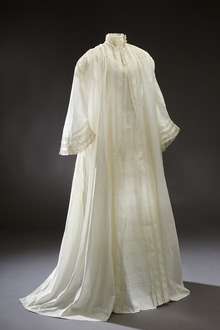Bathrobe

A bathrobe, dressing gown, morning gown or housecoat is a robe, a loose-fitting outer garment, which may be worn by men or women. A dressing gown may be worn over nightwear or other clothing, or with nothing underneath. Dressing gowns are typically worn around the house and bathrobes may sometimes be worn after a body wash or around a pool. They may be worn for warmth, as a convenient covering over nightwear when not being in bed, or as a form of lingerie. A dressing gown or a housecoat is a loose, open-fronted gown closed with a fabric belt that is put on over nightwear on rising from bed, or, less commonly today, worn over some day clothes when partially dressed or undressed in the morning or evening (for example, over a man's shirt and trousers without jacket and tie). A bathrobe is a dressing gown made from towelling or other absorbent fabric, and may be donned while the wearer's body is wet, serving both as a towel and a body covering.
The regular wearing of a dressing gown by men about the house is derived from the 18th-century wearing of the banyan in orientalist imitation.[1] The Japanese yukata is an unlined, cotton kimono worn as a bathrobe or as summer outdoor clothing.
Styles of fabrics
Bathrobes are generally made of four different fabrics:[2]
- Cotton: Cotton is a natural fiber consisting primarily of cellulose and is one of the most commonly used fibers in textile manufacturing. Due to the hydrophilic nature of cellulose, cotton absorbs water easily and is frequently used by the beach, pool, or following a shower. Cotton robes are especially suited to use in hot climates because cotton tends to absorb perspiration.
- Silk: Silk dressing gowns are popular because of their look and feel, but can be relatively expensive. Silk robes are very thin and lightweight, and are not particularly suited to wet situations because they lack the surface area and polarity necessary to absorb water.[3] However, silk dressing gowns are the traditional choice, since they are not worn after bathing.
- Microfiber: Microfiber is an extremely fine synthetic fiber, typically made of cellulose or polyester, that can be woven into textiles to mimic natural-fiber cloth. Modern microfibers are developed to maximize breathability and water absorption and can be thinner than the width of human hair. Much like silk, robes made out of microfiber are light in weight and are very soft to the touch. Microfiber is flammable.
- Wool: Wool bathrobes are common in colder climates.
- Nylon: Nylon is a synthetic fiber occasionally used in inexpensive dressing gowns. It is valued for its ability to be cleaned easily.
Styles of weave
Bathrobes are also categorized by their shape of weave:
- Flannel: Flannel is a soft woven fabric, made from loosely spun yarn, usually cotton or wool.
- Terry: Terry is a pile fabric, usually woven of cotton, with uncut loops on both sides, used for bath towels and robes. The longer and denser the loops are, more absorbent the bathrobes are.
- Velour: Velour is a fabric with cut loops. Velour bathrobes are typically made with terry inside, as terrycloth absorbs water better than velour. Velour gives the bathrobe luxury, coziness, and makes the garment softer to the touch.
- Waffle: Waffle fabric has good water absorbency, is loose and has a distinctive "gridlike" appearance. For most part, these bathrobes are designed for their light weight. "Pique" is a type of waffle weave that can be applied to cotton, velour, silk, and other fabrics.
Styles of collars
.jpg)
There are varieties of collars for bathrobes:
- Shawl collar: So called because the collar closes about the neck just like a shawl. The shawl collar is borrowed from its use on men's evening wear, the dinner jacket and smoking jacket, and is common on traditional dressing gowns.
- Kimono: This is a traditional Japanese garment and the name literally translates to ‘thing to wear’.[4] The kimono style robe actually has no collar per se.
- Hooded: A hood is sewn into the neckline, which can be worn over the head to keep it warm and help dry wet hair.
Styles of sculpture
The sculpture refers to the texture or styling of the bathrobe's fabric. The sculpture of a robe not only provides aesthetic appeal, but also affects the absorbency and the hang of the item. The sculpture is a pattern sewn into the terry cloth, velour, or other fabric that reduces bulk, increases suppleness, and yields a more graceful hang on thicker styles. There are several varieties of fabric sculptures for robes:
- Window Pane: A box or checkerboard pattern in various sizes
- Zig Zag: A plush, repeating "Z" pattern
- Ribbed: A sculpture design that yields alternating vertical lines of plush material and sewn material
- Waves: Similar to the Zig Zag sculpture, but with gentler angles
See also
References
- ↑ In 1888, Coffignon describes it an Armenian clothing which started to be worn under Louis XV, "costume arménien qui commença à être porté sous le règne de Louis XV"(Les coulisses de la mode. Paris vivant, p.123. A la librairie illustrée)
- ↑ "Why Terry Cotton Bathrobes?". bathrobes.net.
- ↑ Articler.com, Bath Robes, retrieved 2007-11-12
- ↑ "Glossary". mensdressinggowns.org.
Further reading
 Media related to Bathrobes at Wikimedia Commons
Media related to Bathrobes at Wikimedia Commons